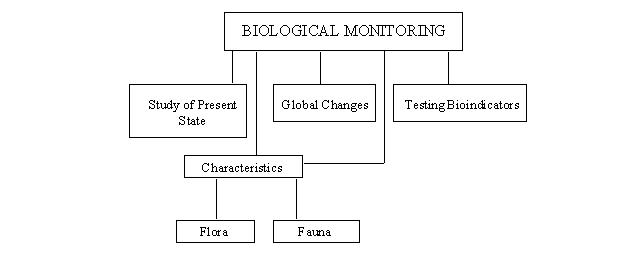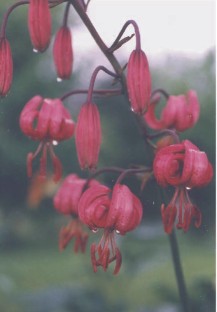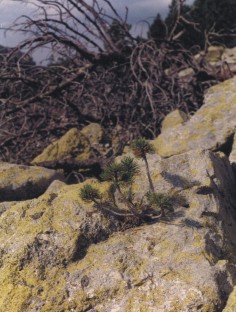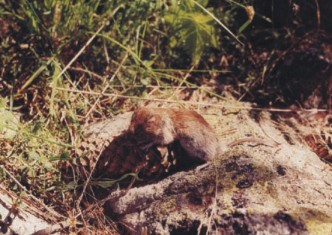4.4. BIOLOGICAL MONITORING
This type of monitoring (Figure 5) was actively developed for flora
and fauna studies, and especially – for heavy metal and radioactive element
migration in the different ecosystem components.

Figure 5. Biological monitoring
A careful phytomonitoring [27,28,29]
was carried out in different part of the Rila mountain. In this connection
the following  biotic
parameters were used:
biotic
parameters were used:
-
listing of the species in the control sites;
-
visual estimation of monitor habitus;
-
micro topographic mapping of the control sites;
-
phenology;
-
statistics of the variability;
-
karyotype analysis;
-
pigmental analysis;
-
isoensyme analysis.
Phytomonitoring for chemical pollution was carried out.
The main results of these studies could be summarized as follows:
-
The investigation of nine moss species from the Rila Mountain shows [30]
that Eurhynchium praelongum is an accumulative biomonitor for Pb,
Cd, Sr, K, Mg, P, S and N, whereas Pohlia drummondii has a greater
accumulative capacity for Zn, Cu, Ni, Co, Fe, Al and Ba.
-
Among the aquatic bryophyte species investigated [31]
in the Rila Mountain Philonotis seriata is the bioconcentrator of
P, Mg, S, Fe, Al, Mn, Zn, Cu, Cd, Co, Ni, Se, Cr and Pb.
Using the results obtained from the biomonitor analysis,
it has been shown that:
-
The level of air pollution with heavy metals (using mosses as biomonitors)
is low. The concentrations found are within the limit for the background
level for Western, Northern and Central Europe.
-
The investigated annual dynamics of macro- and micro elements [32]
in the needle twigs of Norway spruce in the last 10 years shows
low heavy metal accumulation as a consequence of the low level of air and
soil pollution.
Special attention has been paid to the Ecomonitoring
of forests in the Rila Mountain (1986 - 1995) [33].
Forests cover  about
59% of the total area of the mountain.
about
59% of the total area of the mountain.
It has been established that the heavy metal content
of the soils is not of a technogenic origin. The stands are weakly affected
by atmospheric emissions. The heavy metals migrate in the soils. The changes
in the ionic and chemical composition of the lysimetric water show that
they move in a descending direction along the soil profile and are always
accompanied by sulphate ions.
The spatial distribution of insects in the Rila
Mountain, especially of Carabidae fauna, was studied [38].
The study of soil radioactivity and of the associated fauna provides grounds
to assume that these insects accumulate radionucleides from their environment
with different intensities and could be applied as bioindicators [39].
Zoo monitoring was also performed as an assessment
of antropogenic influence on biomonitor vertebrate species from different
regions at different altitudes in the Rila Mountain.
Bioaccumulation and heavy metal and toxic element
distribution in different organs, tissues and in the carcass of the indicated
species were investigated too [34,35,36].
The organism physiological status of different animal populations was tested
using several morphophysiological methods, and a cytogenetic analysis of
some small mammals was made.
The results of the radiological state of the monitor
species: small mammals, fishes and amphibians, obtained controlling the
total beta activity show any significant differences for all of the investigated
regions, varying from 2 to 7 Bg. g. -1 [37].
The results of bioaccumulation and distribution of heavy metals and
toxic elements (Cr, Mn, Ni, Cu, Zn, As, Se, Sr, Ag, Cd, Hg and Pb) in different
tissues and organs - livers, kidneys, spleens, bones, muscles and in the
body of the investigated small mammals show that the lowest concentrations
of the most toxic elements lead, cadmium and mercury were recorded in the
samples from the pine vole (Pitymys subterraneus) and the forest
dormouse (Dryomys nitedula). The highest values of the same elements
were recorded in the body and in the bank vole (Clethrionomys glareolus)
and in the liver and in the kidneys  of
the snow vole (Chionomys nivalis) [36].
of
the snow vole (Chionomys nivalis) [36].
Cytogenetic analyses (chromosome aberrations) and
haematological indices in the monitor species: pine vole (Pitymys subterraneus),
bank vole (Clethrionomys glareolus), yellow necked wood mouse (Apodemus
flavicollis) and common shrew (Sorex araneus) were examined
[35].
The results of the study of haematological indices
show that the mean values of haemoglobin, haematocrit and erythrocytes
in the monitor species were similar to the results obtained for the same
rodent species from the same altitude [35]. There were
no deviations in the size, shape and the banding in the erythrocyte’s morphology.
Hypochromy and anisocytosis were not observed. Polychromatophilic erythrocytes
were noticed only in one individual of the bank vole. No pathogenic inclusions
and changes as basophilic granulation or micronuclei were recorded.
The cytogenetic studies showed [35],
that structural and numerical aberrations on well spread metaphase plates
could be estimated. Predominantly they were breaks, exchanges, centromeric
and telomeric attachments, polyploidity. The percentage of the aberrant
mitosis was about 7. The differences were statistically significant (p>0.05)
between the percentage of aberrant mitoses found in the animals from the
Maliovitza and the Beli Iskar artificial dam region. The analysis of the
metaphases showed that the longer chromosomes were quite susceptible to
break compared to samples from any other region. The aberration frequency
assess in the yellow necked mouse and in the bank vole from the Beli Iskar
region (5.6 and 6.5) were different from the spontaneous frequency values
and appeared to be not spontaneous.
Home Previous
Next


 biotic
parameters were used:
biotic
parameters were used:
 about
59% of the total area of the mountain.
about
59% of the total area of the mountain.
 of
the snow vole (Chionomys nivalis) [36].
of
the snow vole (Chionomys nivalis) [36].